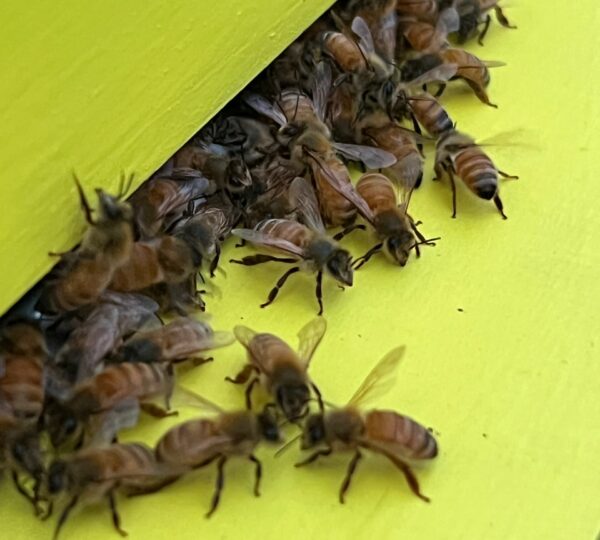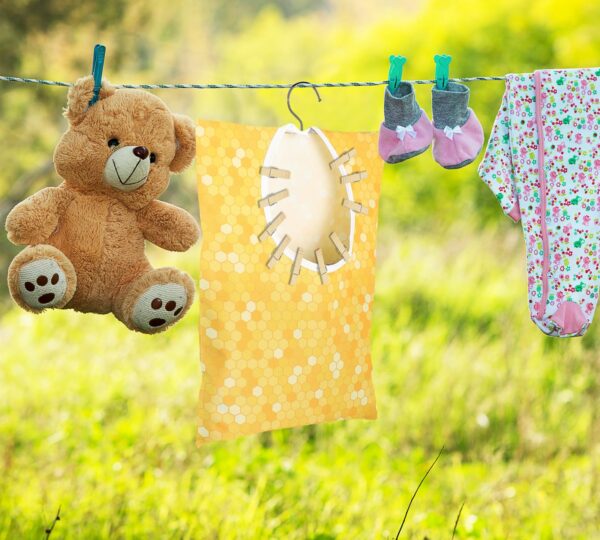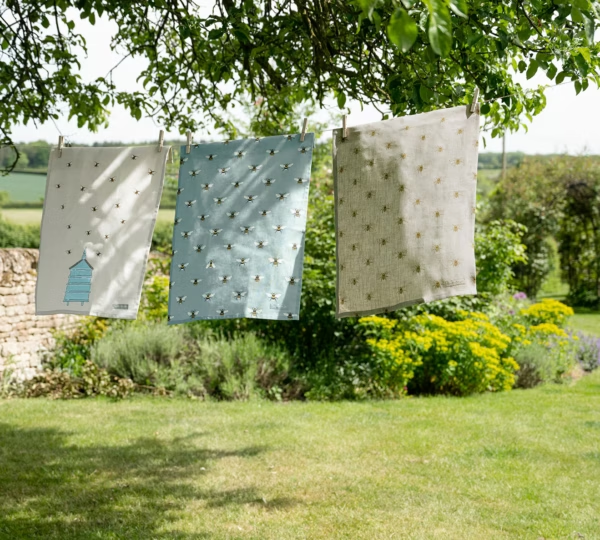Drying clothes outside is a familiar habit in many households, especially during warm and sunny days. Fresh air and sunlight naturally soften fabrics, leaving clothing with a clean outdoor scent. Yet, one unexpected situation can surprise many people: bees landing on freshly washed clothes. Although it may feel alarming, there are natural reasons behind this behavior.
Bees are highly sensory creatures. Their sense of smell, vision, and ability to detect warmth guide them through the world. They rely on these instincts to find flowers, gather nectar, collect water, and communicate with their hive. When laundry is hung outdoors, it can sometimes produce signals that bees interpret as familiar cues found in nature.
Many modern detergents and fabric softeners contain floral or fruity fragrances. These pleasant scents may remind bees of flowers, leading them to investigate. A freshly washed shirt or towel can carry these fragrances in a way that mimics natural blooms. Bees may land on the clothing, believing they have discovered a potential nectar source.

In addition to scent, moisture is another factor that attracts bees. Bees need water for several purposes, including cooling their hive and diluting thick honey. If laundry is slightly damp or has pockets of retained moisture, bees may approach it as a possible water source. This is especially common during hot days when natural water sources are limited.
Color also plays an important role. Bees are naturally drawn to bright and light-colored objects. Shades like white, yellow, and pastels resemble the colors of flowers in the wild. Clothing in these tones stands out visually, making it more appealing to bees searching for blooms.
Sunlight influences behavior as well. Clothes warmed by the sun can radiate gentle heat. Bees sometimes seek warmth, particularly in cooler weather or early in the morning. A sun-warmed garment hanging outdoors may seem like a comfortable resting spot.
Although finding bees on clothing can be surprising, it is not necessarily dangerous. Bees are generally non-aggressive creatures. They rarely attack unless they feel directly threatened. However, discovering bees on intimate garments such as underwear or shirts can be startling and may lead to an instinctive reaction that risks provoking them.
The most important thing is to stay calm. Swatting or shaking clothes aggressively can frighten bees. When bees feel vibration or rapid movement, they may interpret it as a threat. A frightened bee may sting as a last resort to protect itself.

Version 1.0.0
If you find bees on your clothing, one of the simplest solutions is to wait. Bees typically fly away on their own after realizing the fabric does not contain nectar. They tend to lose interest quickly once they confirm there is no food available.
Another option is to remove the clothing gently. Using a stick or hanger to lift the garment without direct contact can help you avoid disturbing the bees. Moving the clothing into a shaded area or indoors usually encourages them to leave.
To prevent bees from being attracted to laundry in the first place, consider switching to fragrance-free detergents. Unscented or hypoallergenic products reduce the floral signals that may confuse bees. Many households find that using simple, clean formulas not only deters insects but also reduces skin irritation.
Avoid drying clothes during the hours when bees are most active. Bees are busiest in the middle of the day when the sun is strongest. Hanging laundry early in the morning or late in the afternoon may reduce the chances of attracting insects.
Shaking clothes thoroughly before bringing them indoors is another helpful step. Even if bees land on garments briefly, this movement usually encourages them to fly away.
If bees frequently visit your outdoor drying area, consider making adjustments. Drying laundry in a partially shaded space can reduce warmth and fragrance dispersion. Installing a mesh barrier or screen around your drying area can also limit access for insects while still allowing airflow.

Version 1.0.0
Some households choose to alternate between indoor and outdoor drying depending on the season. During peak bee activity or in regions with high bee populations, drying clothes indoors may be more practical.
It is also helpful to remember that bees are essential to the environment. They pollinate flowers, crops, and trees, playing a major role in maintaining the world’s ecosystems. Treating bees gently benefits both people and nature.
Understanding why bees behave the way they do can ease concerns. Their attraction to laundry is not a sign of aggression but rather a result of their natural instincts. Scents, colors, moisture, and warmth can all signal floral cues, even when none exist.
By making a few small adjustments to your laundry routine, you can reduce the likelihood of bees gathering on your clothes. Simple measures like choosing unscented detergents, adjusting drying times, or providing a shaded drying area can make a noticeable difference.
Taking a moment to observe bees can also offer insight into their curious behavior. They explore their environment constantly, searching for resources that help sustain their colony. Laundry just happens to mimic some of those resources occasionally.
When bees do land on clothing, it is typically brief and harmless. They are simply trying to determine whether the item offers food, water, or warmth. Once they realize it does not, they continue on their way.

Being patient and cautious ensures that both you and the bees stay safe. Avoid sudden movements or attempts to brush bees away with force. Calm handling reduces the risk of accidental stings.
If laundry regularly attracts bees, you may want to examine the products you use. Strong floral scents are the most common factor. Switching to neutral-smelling detergents often solves the issue entirely.
Outdoor drying remains a natural, energy-saving option that many people enjoy. With a few preventive steps, you can continue using this method while keeping bees at a distance.
In the end, discovering bees on clothes is more surprising than dangerous. Bees are simply responding to familiar signals in their environment. By understanding their motivations, it becomes easier to manage the situation with confidence and care.
With thoughtful practices and gentle awareness, you can keep your laundry bee-free while supporting the important role bees play in the ecosystem. Their presence, while sometimes unexpected, is a reminder of their essential contribution to nature.
Drying clothes outside is a familiar habit in many households, especially during warm and sunny days. Fresh air and sunlight naturally soften fabrics, leaving clothing with a clean outdoor scent. Yet, one unexpected situation can surprise many people: bees landing on freshly washed clothes. Although it may feel alarming, there are natural reasons behind this behavior.
Bees are highly sensory creatures. Their sense of smell, vision, and ability to detect warmth guide them through the world. They rely on these instincts to find flowers, gather nectar, collect water, and communicate with their hive. When laundry is hung outdoors, it can sometimes produce signals that bees interpret as familiar cues found in nature.
Many modern detergents and fabric softeners contain floral or fruity fragrances. These pleasant scents may remind bees of flowers, leading them to investigate. A freshly washed shirt or towel can carry these fragrances in a way that mimics natural blooms. Bees may land on the clothing, believing they have discovered a potential nectar source.

In addition to scent, moisture is another factor that attracts bees. Bees need water for several purposes, including cooling their hive and diluting thick honey. If laundry is slightly damp or has pockets of retained moisture, bees may approach it as a possible water source. This is especially common during hot days when natural water sources are limited.
Color also plays an important role. Bees are naturally drawn to bright and light-colored objects. Shades like white, yellow, and pastels resemble the colors of flowers in the wild. Clothing in these tones stands out visually, making it more appealing to bees searching for blooms.
Sunlight influences behavior as well. Clothes warmed by the sun can radiate gentle heat. Bees sometimes seek warmth, particularly in cooler weather or early in the morning. A sun-warmed garment hanging outdoors may seem like a comfortable resting spot.
Although finding bees on clothing can be surprising, it is not necessarily dangerous. Bees are generally non-aggressive creatures. They rarely attack unless they feel directly threatened. However, discovering bees on intimate garments such as underwear or shirts can be startling and may lead to an instinctive reaction that risks provoking them.
The most important thing is to stay calm. Swatting or shaking clothes aggressively can frighten bees. When bees feel vibration or rapid movement, they may interpret it as a threat. A frightened bee may sting as a last resort to protect itself.

Version 1.0.0
If you find bees on your clothing, one of the simplest solutions is to wait. Bees typically fly away on their own after realizing the fabric does not contain nectar. They tend to lose interest quickly once they confirm there is no food available.
Another option is to remove the clothing gently. Using a stick or hanger to lift the garment without direct contact can help you avoid disturbing the bees. Moving the clothing into a shaded area or indoors usually encourages them to leave.
To prevent bees from being attracted to laundry in the first place, consider switching to fragrance-free detergents. Unscented or hypoallergenic products reduce the floral signals that may confuse bees. Many households find that using simple, clean formulas not only deters insects but also reduces skin irritation.
Avoid drying clothes during the hours when bees are most active. Bees are busiest in the middle of the day when the sun is strongest. Hanging laundry early in the morning or late in the afternoon may reduce the chances of attracting insects.
Shaking clothes thoroughly before bringing them indoors is another helpful step. Even if bees land on garments briefly, this movement usually encourages them to fly away.
If bees frequently visit your outdoor drying area, consider making adjustments. Drying laundry in a partially shaded space can reduce warmth and fragrance dispersion. Installing a mesh barrier or screen around your drying area can also limit access for insects while still allowing airflow.

Version 1.0.0
Some households choose to alternate between indoor and outdoor drying depending on the season. During peak bee activity or in regions with high bee populations, drying clothes indoors may be more practical.
It is also helpful to remember that bees are essential to the environment. They pollinate flowers, crops, and trees, playing a major role in maintaining the world’s ecosystems. Treating bees gently benefits both people and nature.
Understanding why bees behave the way they do can ease concerns. Their attraction to laundry is not a sign of aggression but rather a result of their natural instincts. Scents, colors, moisture, and warmth can all signal floral cues, even when none exist.
By making a few small adjustments to your laundry routine, you can reduce the likelihood of bees gathering on your clothes. Simple measures like choosing unscented detergents, adjusting drying times, or providing a shaded drying area can make a noticeable difference.
Taking a moment to observe bees can also offer insight into their curious behavior. They explore their environment constantly, searching for resources that help sustain their colony. Laundry just happens to mimic some of those resources occasionally.
When bees do land on clothing, it is typically brief and harmless. They are simply trying to determine whether the item offers food, water, or warmth. Once they realize it does not, they continue on their way.

Being patient and cautious ensures that both you and the bees stay safe. Avoid sudden movements or attempts to brush bees away with force. Calm handling reduces the risk of accidental stings.
If laundry regularly attracts bees, you may want to examine the products you use. Strong floral scents are the most common factor. Switching to neutral-smelling detergents often solves the issue entirely.
Outdoor drying remains a natural, energy-saving option that many people enjoy. With a few preventive steps, you can continue using this method while keeping bees at a distance.
In the end, discovering bees on clothes is more surprising than dangerous. Bees are simply responding to familiar signals in their environment. By understanding their motivations, it becomes easier to manage the situation with confidence and care.
With thoughtful practices and gentle awareness, you can keep your laundry bee-free while supporting the important role bees play in the ecosystem. Their presence, while sometimes unexpected, is a reminder of their essential contribution to nature.